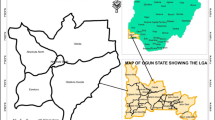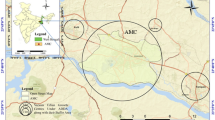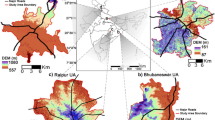Abstract
Geospatial techniques such as remote sensing and Geographic Information System are very important for studying the dynamic process of land use. To analyze the land use change and assess the driving force, SPOT satellite images of 2005, 2010, 2015 and 2018 were used. Classification of land use was applied using Normalized Difference Vegetation Index and Maximum Likelihood Technique in ENVI 5.3. Transition images and matrix were applied using Arcgis10.5 with the Excel PivotTable function. To determine the driving forces of land use change in the study area, Quantitative and Qualitative analysis were applied. Data were compared with statistical analysis using Principal Component Analysis (PCA). Results showed that, the images of the study area were categorized into vegetation (arable land, garden, woodland, grassland, water and agriculture), construction (industrial and transportation) and unutilized land (salt marsh, sandy land, bare land and gully erosion land). From 2005 to 2018, constriction land use greatly increased from 100.41 km2 (2.88%) and 305.13 km2 (8.76%), respectively. Vegetation was decreased from 3190 km2 (91.55%) 3028 km2 (86.91%) in 2005 and 2018, respectively. Results of the comprehensive index of land use degree, dynamic degree, quantitative and qualitative analysis show major changes in land use of the area that caused by human activities especially new developments during the period of the study. The results showed that the Ningdong base in 2005–2018 has been in the stage of sustainable development, mainly in the conversion of grassland, forest land and cultivated land to construction land. High values of rate of change in land use related to the development and new construction and building area. This development might be as a result of anthropogenic activities through urban growth coupled with its potential impacts on urban climate. The principal component analysis shows that human activities drive the change of land use pattern in Ningdong, mainly including the policy of closing the grazing ban, industrialization and scale, population growth and urbanization. Results can provide effective data for the future ecological environment protection and sustainable development of Ningdong Energy Base. Remote sensing is a good technique for assessing the actual sequence in the development of any area that may be caused by human activities.







Similar content being viewed by others
References
Baiming, C., Xinwei, L., & Hong, Y. (2003). Review of the latest progress in LUCC research. Progress in Geographic Science, 22(1), 22–29.
Bin, M., Zhiyou, X., & Chongde, B. (2011). Dynamic monitoring and analysis of soil and water conservation ecological environment in Ningdong energy and chemical industry base. Water Conservancy & Water Conservation in China, 14, 53–56.
Chaolin, G. (1999). Study on the mechanism of land use/land cover change in Beijing. Journal of Natural Resources, 14(4), 307–312.
Chen, F., Gang, C., & Haosheng, B. (2001). Study on land use change and humanistic driving force mechanism in urban fringe. Journal of Natural Resources, 16(3), 204–210.
Chuanzhe, L., Fuliang, Y., & Jia, L. (2011). Quantitative study on land use/cover change and driving force in the middle reaches of the Heihe River in the past 20 years. Journal of Natural Resources, 26(3), 353–363.
Cohen, J. E. (1995). How many people can the earth support?. New York: W. W. Norton and Company.
Costanza, R., d’Arge, R., De Groot, R., Farber, S., Grasso, M., Hannon, B., Limburg, K., Naeem, S., O’neill, R.V., & Paruelo, J. (1997). The value of the world’s ecosystem services and natural capital. Nature, 387, 253–260
Gibson, P., & Power, C. (2000). Introductory remote sensing: Digital image processing and applications. London: Rout ledge.
Gould, S. F. (2012). Comparison of post-mining rehabilitation with reference ecosystems in Monsoonal Eucalypt Woodlands, Northern Australia. Restoration Ecology, 20(2), 250–259.
Hezhen, Z., Shengtian, Y., & Qiuwen, Z. (2014). Analysis of land use/cover change and driving force in Yanhe River Basin from 2000 to 2010. Arid Area Resources and Environment, 28(4), 15–20.
Huajun, Y., & Jianhong, Z. (2007). Study on the synchronous utilization model of water, land and coal resources in coal mining areas. Resources Science, 29(5), 90–91.
Huiran, H., Chengfeng, Y., & Jinping, S. (2015). Characteristics and driving mechanism of land use change in Beijing. Economic Geography, 35(5), 148–154.
Jiangxing, M., Zhigang, L., & Xiaopei, Y. (2008). Human factors analysis of spatial and temporal changes of land use in Shenzhen under the background of rapid urbanization. Resources Science, 30(6), 939–948.
Jie, F., Yu, X., & Yang, S. (2003). Humanistic geographical perspective and new proposition of land use change research. Progress in Geography, 22(1), 1–10.
Jijun, M., Xiuqin, W., & Zhengguo, L. (2003). Study on land use/cover change in Heihe River Basin from 1988 to 2000. Journal of Peking University (Natural Science Edition), 40(6), 922–929.
Jinpeng, L., Fei, W., & Xingmin, M. (2010). Effects of land use change on the value of ecological services in Yanhe River Basin. Soil and Water Conservation Research, 17(3), 110–114.
Jiyuan, L. (1992). Land use in Tibet Autonomous Region (pp. 1–60). Beijing: Science Press.
Jun, Y. (2016). Study on the land ecology and geological environment of Ningxia Ningdong Energy and Chemical Industry Base. Master’s thesis of China University of Geosciences, pp 27–28.
Junfeng, Z. (2008). Study on land use change and ecological environment response in coal mining areas, pp. 19–20.
Lausch, A., & Biedermann, F. (2000). Analysis of temporal changes in the Lignite mining region south of Leipzig using GIS and landscape metrics [A]. In T. Clare & D. Howard (Eds.), Quantitative approaches to landscape ecology [C]. 6th–10th September 2000, Bangor, IALE (UK), pp. 71–83.
Meiling, A., Zhang, B., & Lijun, S. (2013). Quantitative analysis of land use dynamics and influencing factors in the upper reaches of Heihe River. Journal of Glacial Frozen Soil, 35(2), 355–356.
Peijun, S., Peng, G., & Xiaobing, L. (2000). Methods and practices of land use/cover change research (pp. 99–134). Beijing: Science Press.
Santo, E. L., & Sanchez, L. E. (2002). GIS applied to determine environmental impact indicators made by sand mining in a floodplain in southeastern Brazil. Environmental Geology, 41(6), 628–637.
Sisi, X., Chunxi, W., & Jinyu, C. (2012). Analysis of land use change and driving factors in Taihu Lake Region: 1980 to 2005. Journal of Agricultural Engineering, 28(23), 1–2.
Wanqi, Y., & Shidong, Z. (1997). A review of research models on land use and land cover change. Journal of Natural Resources, 12(2), 170–175.
Wood, D., & Lenné, J. M. (2005). Received Wisdom’ in agricultural land uses policy: 10 years on from Rio. Land Use Policy, 22(2), 75–93.
Xiubin, L. (1996). International research trends in land use/land cover change in the core areas of global environmental change research. Journal of Geographical Sciences, 51(6), 553–558.
Xiulan, W. (2010). Analysis of population factors in land use/land cover change. Resources Science, 22(3), 39–42.
Xiulan, W., & Yuhai, B. (1999). Discussion on research methods of land use dynamic change. Progress in Geography Science, 18(1), 82–87.
Youning, X., Zheng, W., & Zhichang, Z. (2002). Environmental geological problems of different types of mineral development in Northwest China and their main causes. Northwest Geology, 35(1), 45–46.
Yuchu, X., Jie, G., & Caixia, Z. (2012). Evaluation of ecosystem service value of land use change in oasis in arid area: A case study of Jinta County, Gansu Province. Soil and Water Conservation Research, 19(2), 165–170.
Yufeng, M., & Chunxiang, G. (2013). Influence of climate change on land use in the farming-pastoral ecotone. Resources Science, 4, 24–25.
Zhaoling, H., Peijun, D., & Wei, Z. (2007). Analysis of land use change in Xuzhou coal mining area. Journal of Geographical Sciences, 62(11), 1204–1214.
Zhengfu, Q. (2000). Review of land reclamation research in coal mines at home and abroad. China Land Science, 14(1), 6–11.
Funding
Was supported by grant from Ningxia Institute of Remote Sensing Surveying and Mapping, Yinchuan 750021, China. This work was carried out under research program of Ningxia Institute of Remote Sensing Surveying.
Author information
Authors and Affiliations
Corresponding author
Ethics declarations
Conflict of interest
The authors declare that they have no conflicts of interest.
Human and animal rights
All procedures performed in studies involving human participants were in accordance with the ethical standards of the institutional and/or national research committee and with the 1964 Helsinki Declaration and its later amendments or comparable ethical standards.
Additional information
Publisher's Note
Springer Nature remains neutral with regard to jurisdictional claims in published maps and institutional affiliations.
Rights and permissions
About this article
Cite this article
El-Hamid, H.T.A., Caiyong, W. & Yongting, Z. Geospatial analysis of land use driving force in coal mining area: case study in Ningdong, China. GeoJournal 86, 605–620 (2021). https://doi.org/10.1007/s10708-019-10078-2
Published:
Issue Date:
DOI: https://doi.org/10.1007/s10708-019-10078-2




